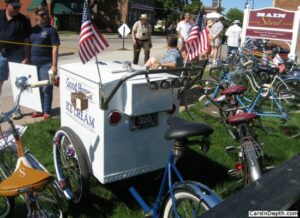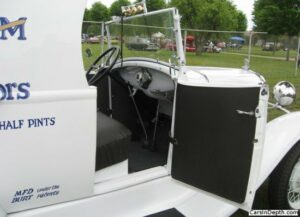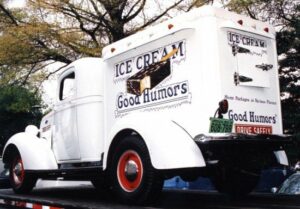Remembering the Good Humor truck
It’s summertime, when ice cream trucks ply the residential streets of America, playing the same silly songs over and over and over again, or ringing their bells. There was a time when the ringing bells of Good Humor trucks could be heard across America, but now their bells are heard and the trucks are seen primarily at car shows and in museums. A vintage piece of Americana from yesteryear.
The story of the Good Humor truck, interestingly enough, starts with another brand of frozen treat. After an Iowa candy store owner figured out how to successfully coat a slab of vanilla ice cream with a thin chocolate shell and called it the Eskimo Pie in 1919, Harry Burt, who owned an ice cream parlor in Youngstown, Ohio, figured out how to reproduce the process but his daughter Ruth thought it was too messy to eat. Burt had earlier had some success with the Jolly Boy Sucker, a hard candy on a wooden stick. Harry Jr. suggested using one of the wooden sticks as a handle for the chocolate coated ice cream bar. Before deep freezing a batch in the store’s hardening room, the senior Burt inserted a wooden stick in each. They discovered that ice crystals that were formed created a strong enough bond to the wood so it could be used as a handle to eat the ice cream neatly.
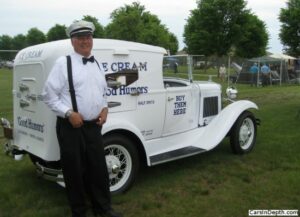
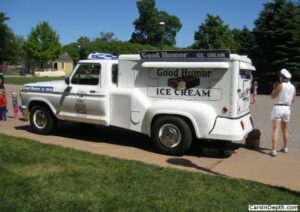
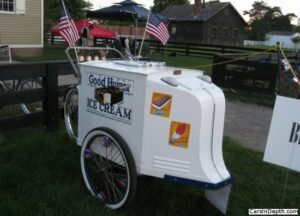
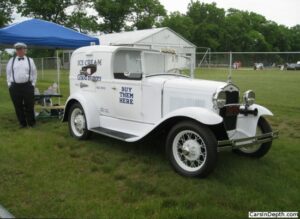
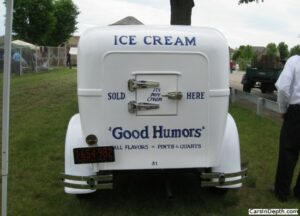
Realizing that the product had potential beyond a single ice cream parlor, Burt bought a dozen Ford vending trucks, outfitted them with primitive freezers to keep the ice cream cold and bells to ring in order to attract kids. The first set of bells were from Harry Jr’s old bobsled. The ice cream bar was named Good Humor, though there are two reasons given for the name. The first was that Harry Burt was capitalizing on a the popular belief that one’s “humor”, one’s general outlook on life was affected by the foods one ate. The other is that the word humors was a synonym for flavors. That’s why some early Good Humor trucks use the plural Good Humors. The trucks were white, as were the drivers’ uniforms, to give the impression of cleanliness. Drivers also wore Sam Brown leather belts and shoes, a cap not unlike a policeman’s cap, and a sash also like a policeman’s, to give a sense of safety and authority, and a coin changer. In addition to trucks, Good Humor bars were sold from push carts and pedal carts, also in white and always with the bobsled bells.
While Burt seemed to have favored Fords, with special bodywork and freezers installed by Hackney Brothers, over the history of the company there have been local and regional Good Humor franchises, and which vehicles they used seemed to have been up to the local operators. There were a number of Chevrolet based Good Humor trucks as well as a number of independent coachbuilders who added the freezers.
Burt tried to patent his new invention but the Patent Office considered them to be too similar to Eskimo Pies. Burt traveled to Washington, D.C. and personally lobbied the Patent Office, which relented, granting him patents on the equipment and processes needed to make a frozen confection on a stick.
Harry Burt died in 1926 and his widow sold out to an investor group from Cleveland which renamed the company Good Humor Corporation of America and started selling franchises. When the owner of the Detroit franchise tried to expand to Chicago in 1929, gangsters demanded protection money. When the $5,000 was not forthcoming, the mobsters torched a number of Good Humor trucks. Ironically, the publicity about the arson got Good Humor established in Chicago. Nationally, the fact that a Good Humor bar was an inexpensive treat that just about anyone could afford grew the brand’s popularity during the Depression.
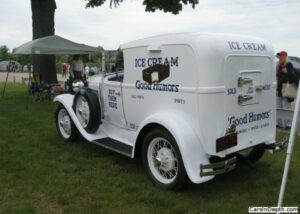
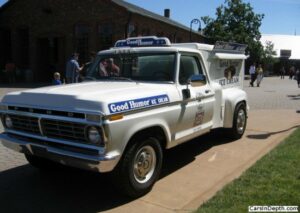
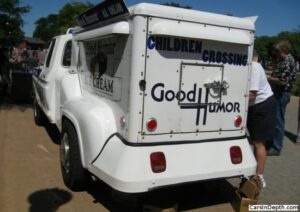
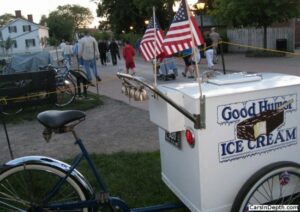
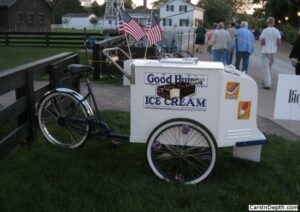
After the end of World War II, Good Humor expanded into the suburbs as the “greatest generation” proceeded to [pro]create what we call baby boomers. By the mid 1950s, truck sales accounted for 90% of the company’s sales, with more than half of their customers 12 years old or younger. The fleet grew to 2,000 trucks. The Good Humor truck became a piece of Americana. There was even a theatrical 1950 movie titled The Good Humor Man, a comedic murder mystery starring Jack Carson that includes what is probably the only car chase scene in movie history that uses a Good Humor truck.
Into the 1960s sales continued to grow but Good Humor started experiencing organized competition from the step-van based Mister Softee trucks. Also, the company had been organized fairly early on and starting in the 1950s it was repeatedly struck by the Teamsters union. By the early 1970s the Good Humor fleet was down to 1,200 trucks.
Also, beginning in 1968, the company had started losing money. Since Good Humor was owned by a conglomerate, Unilever, the loses weren’t fatal but after the first oil crisis in 1973 gasoline prices made truck sales impracticable. The owner of the 1973 Ford F-250 Good Humor truck pictured here told me that it was one of only two made by Hackney that year. When I spoke to Good Humor historian Richard Box, though, he insisted that it couldn’t have been made by Hackney because they stopped making pickup truck based Good Humor trucks in 1969, switching to step-vans. Since the freezers lasted a long time, some were transferred to new chassis and Box suggested that perhaps this was that kind of conversion. However, checking with the owners, they say that while Hackney indeed stopped using pickups to build their Good Humor trucks in 1969, Good Humor did have two 1973 F-250 trucks converted by Hackney on special order for the use of a Florida Good Humor distributor. That means that this is one of the last two traditional Good Humor trucks ever made. Switching to step-vans didn’t change the tide. After a decade of unprofitability, in 1978 Good Humor sold off the remaining fleet for $1,000 to $3,000 per truck, many of them to former Good Humor vendors who started running their own businesses.
As I mentioned, nowadays if you see a Good Humor truck it’s likely to be at some kind of car event. Good Humor truck collectors and restorers have figured out a way to make their hobby help pay for itself, by either renting out their trucks to special events, or by using it to sell ice cream at car shows and the like. Some report grossing $1,000 a day. That’s how I happened across the Mike and Sue Berardi’s 1973 Ford F-250 Good Humor truck (with a freezer box by Hackney) at the Mustang Memories show last summer. A vendor with a display at that show hired the Berardis and their Good Humor Ice Cream truck to hand out free ice cream bars. In real life Mike is director of service engineering for a small family owned enterprise named Ford Motor Company. Mike’s connection to Ford may explain why he and Sue were also slinging Good Humor bars at the recent Motor Muster held on the grounds of Henry Ford’s Greenfield Village.
Not far from where the Berardis were selling Good Humors out of their Good Humor truck at the Motor Muster was the show’s display of vintage bicycles, set up adjacent to the Wright Brothers’ bicycle shop. Sitting out front was a Good Humor bike, or actually a trike, with a cooler made by Milkey, circa 1948, resplendent in Good Humor white and replete with the Burts’ bobsled bells. It’s obviously been restored and from the modern ice cream stickers on it, my guess is that its owners also are at least in the ice cream selling biz part time.
It was fortuitous that there were a Good Humor truck and pedal cart at the Motor Muster. I’d already decided to write about Good Humor trucks after seeing Joe Hornacek’s restored 1931 Ford Good Humor truck on display the week before at the Packard Proving Grounds’ 2014 Cars R Stars show. The featured category at this year’s show was commercial vehicles, and if I recall correctly, this was the first time Hornacek has shown the car since the restoration was completed. He hasn’t even considered using the truck to sell ice cream, though he was giving out free samples to kids.
Hornacek acquired his 1931 Ford Model A Roadster Pickup based Good Humor truck as a literal barn find. It was in pieces in a barn near Port Huron, Michigan. At first he thought it was too far gone to restore but having second thoughts he asked the seller to lay out all the parts on the ground. Hornacek realized there was enough there, particularly from the freezer box, to be able to start a restoration.
The first thing he discovered was that in eight decades of use the truck and freezer had been repaired a number of times, in non-standard ways. He decided to completely reframe the body, using ash wood, as Ford Motor Company did for their bodies. However, once Hornacek got the body frame assembled, he discovered that parts of the original handmade body were out of square by more than an inch. The freezer had been fabricated by an unknown independent coachbuilder. As a result, while most of the truck is original, the sheet metal for the freezer sides had to be reproduced. Once he got the body fabbed, the rest of the restoration was relatively easy because Model A parts, NOS and repros, are readily available today. Some of Hornacek’s build photos are in the gallery below.
The truck’s graphics are based on a 1930 Ford Good Humor truck whose photograph is in the collection of the Smithsonian. That truck has the lettering as “Good Humors” and also has a disclaimer “Mfd under the Burt patents”, no doubt an assurance of quality by a local franchisee. Hornacek’s Ford is a great looking vehicle, which may explain why the Danbury Mint once issued a die cast model of a Model A Good Humor truck that looks very much like his. While the Berardi’s truck has a full cab, Hornacek’s truck has the classic open roof “half cab” that many of us associate with Good Humor trucks.
If you’d like to have your own Good Humor truck, get ready to spend some money and maybe some elbow grease like Joe Hornacek. In 2012, a 1965 Ford Good Humor truck with a concours level restoration sold at auction for $66,000. If you want to do a little restoration work, this 1966 Ford/Hackney Good Humor truck on eBaymotors has a Buy It Now price of $24,500. A previous owner painted it black to use as a promotional vehicle for a radio station. A Darth Vader Good Humor truck is sort of a cool idea, though I doubt Harry Burt would have approved. Actually those Hackney freezers typically have porcelain enameled body panels so you can probably use some kind of chemical stripper to expose the white porcelain below.
You know, owning a vintage Good Humor truck is not exactly an unappealing idea. Those old Ford and Chevy trucks are already collectible and you get to enjoy a special version of a cool vintage truck that makes people smile. If you decide you want to dress up like a Good Humor man and sell a few ice cream bars, how many other ideas can you think of that allow you to make money while hanging out at car shows?
